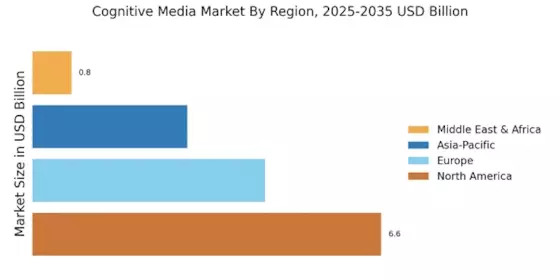Integration of Advanced AI Technologies
The integration of advanced artificial intelligence technologies is transforming the Cognitive Media Market. AI-driven tools are increasingly utilized for content creation, curation, and distribution, allowing for more efficient and effective media strategies. These technologies enable real-time data analysis, which helps in understanding audience preferences and optimizing content delivery. The market is seeing a rise in AI applications, such as natural language processing and computer vision, which enhance user interaction and engagement. As organizations adopt these technologies, the Cognitive Media Market is likely to experience significant growth, with AI-related investments projected to reach billions in the next few years. This trend underscores the importance of technological innovation in shaping the future of media.
Emergence of Interactive and Immersive Media
The Cognitive Media Market is increasingly characterized by the emergence of interactive and immersive media formats. Technologies such as virtual reality and augmented reality are gaining traction, offering users engaging experiences that go beyond traditional media consumption. This shift is driven by consumer demand for more engaging and participatory content, which enhances emotional connections and brand loyalty. Market Research Future indicates that the immersive media segment is expected to grow substantially, with projections suggesting a doubling of market size within the next five years. This trend presents a unique opportunity for companies in the Cognitive Media Market to explore innovative content formats and delivery methods that cater to evolving consumer preferences.
Increased Demand for Personalized Experiences
The Cognitive Media Market is witnessing a pronounced shift towards personalized content experiences. Consumers increasingly seek tailored media that resonates with their individual preferences and behaviors. This trend is driven by advancements in data analytics and machine learning, enabling companies to curate content that aligns with user interests. As a result, businesses are investing heavily in technologies that facilitate personalization, which is projected to enhance user engagement and retention. According to recent estimates, the market for personalized media solutions is expected to grow at a compound annual growth rate of over 20 percent in the coming years. This surge indicates a robust opportunity for companies within the Cognitive Media Market to innovate and differentiate their offerings.
Growing Importance of Data Privacy and Security
As the Cognitive Media Market expands, the importance of data privacy and security becomes increasingly paramount. With the rise of personalized content comes the responsibility to protect user data and ensure compliance with regulations. Consumers are becoming more aware of their data rights, leading to heightened expectations for transparency and security from media companies. This trend is prompting organizations to invest in robust data protection measures and privacy-centric technologies. The market is likely to see a shift towards solutions that prioritize user consent and data integrity, which could reshape how companies operate within the Cognitive Media Market. As a result, businesses that prioritize data privacy may gain a competitive edge in attracting and retaining customers.
Expansion of Multi-Platform Distribution Channels
The Cognitive Media Market is experiencing a notable expansion of multi-platform distribution channels. As consumers increasingly engage with media across various devices and platforms, companies are adapting their strategies to ensure content accessibility and reach. This trend is driven by the proliferation of mobile devices, smart TVs, and streaming services, which have transformed how audiences consume media. Market analysis suggests that companies that effectively leverage multi-platform strategies are likely to enhance their visibility and engagement. The ability to deliver consistent and cohesive content across different channels is becoming a critical success factor in the Cognitive Media Market. This expansion presents opportunities for innovation in content delivery and audience engagement.


















Leave a Comment